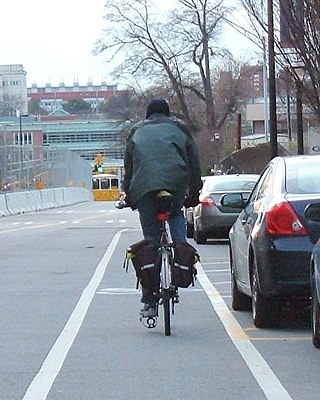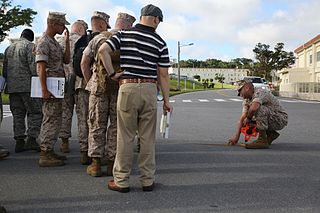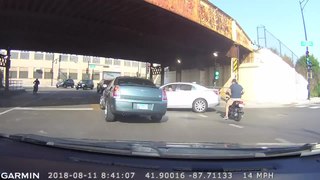
A motorcycle is a two or three-wheeled motor vehicle steered by a handlebar from a saddle-style seat.

Road traffic safety refers to the methods and measures used to prevent road users from being killed or seriously injured. Typical road users include pedestrians, cyclists, motorists, vehicle passengers, and passengers of on-road public transport.
The Royal Society for the Prevention of Accidents (RoSPA) is a British charity that aims to save lives and prevent life-changing injuries which occur as a result of accidents. In the past, it has successfully campaigned on issues of road safety, including playing an integral role in the introduction of drink-drive legislation, the compulsory wearing of seatbelts and the ban on handheld mobile phones while driving, as well as on issues of occupational health and safety.

Road rage is aggressive or angry behavior exhibited by motorists. These behaviors include rude and verbal insults, yelling, physical threats or dangerous driving methods targeted at other drivers, pedestrians or cyclists in an effort to intimidate or release frustration. Road rage can lead to altercations, damage to property, assaults, and collisions that result in serious physical injuries or even death. Strategies include cutting motorists off, inappropriate honking, using obscene gestures, flipping off another driver, swerving, tailgating, brake checking, and attempting to fight.

Tailgating is the action of a driver driving behind another vehicle while not leaving sufficient distance to stop without causing a collision if the vehicle in front stops suddenly.

Dooring is the act of opening a motor vehicle door into the path of another road user. Dooring can happen when a driver has parked or stopped to exit their vehicle, or when passengers egress from cars, taxis and rideshares into the path of a cyclist in an adjacent travel lane. The width of the door zone in which this can happen varies, depending upon the model of car one is passing. The zone can be almost zero for a vehicle with sliding or gull-wing doors or much larger for a truck. In many cities across the globe, doorings are among the most common and injurious bike-vehicle incidents. Any passing vehicle may also strike and damage a negligently opened or left open door, or injure or kill the exiting motorist or passenger.

Motorcycle safety is the study of the risks and dangers of motorcycling, and the approaches to mitigate that risk, focusing on motorcycle design, road design and traffic rules, rider training, and the cultural attitudes of motorcyclists and other road users.

Bicycle safety is the use of road traffic safety practices to reduce risk associated with cycling. Risk can be defined as the number of incidents occurring for a given amount of cycling. Some of this subject matter is hotly debated: for example, which types of cycling environment or cycling infrastructure is safest for cyclists. The merits of obeying the traffic laws and using bicycle lighting at night are less controversial. Wearing a bicycle helmet may reduce the chance of head injury in the event of a crash.
State motorcyclists' rights organizations (SMROs) exist in about 32 US states, 25 of which call themselves "ABATE of ," the rest going by various other names. SMROs advocate for a point of view in motorcycling that is, in general, opposed to mandatory helmet laws, required motorcycle safety inspections, mandatory rider training and licensing, and other similar regulation. Instead SMROs favor optional or voluntary motorcycle rider safety education, training, and licensing, and greater public awareness of motorcyclist safety issues. They also favor stronger penalties for car driver infractions such as right of way violations, or when drivers are at fault in accidents that harm motorcycle riders. SMRO activities include lobbying legislatures, letter writing campaigns, and paying for public service announcements and political advertisements. To carry out lobbying at the national level, a coalition of SMRO's created the Motorcycle Riders Foundation (MRF) to lobby in Washington DC. The SMROs and MRF are often allied with the American Motorcyclist Association (AMA) on legislative issues.

This is a list of numbers of motorcycle deaths in U.S. by year from 1994 to 2014. United States motorcycle fatalities increased every year for 11 years after reaching a historic low of 2,116 fatalities in 1997, then increased to over 5,000 around 2008 and then plateaued in the 4 to 5 thousands range in the 2010s. In nine years motorcycle deaths more than doubled from the late 1990s to 2008. Despite providing less than 1% of miles driven, they made up 15% of traffic deaths in 2012.

Motorcycle training teaches motorcycle riders the skills for riding on public roads. It is the equivalent of driver's education for car drivers. Training beyond basic qualification and licensing is available to those whose duty includes motorcycle riding, such as police, and additional rider courses are offered for street riding refreshers, sport riding, off-road techniques, and developing competitive skills for the motorcycle racetrack.

Traffic collision reconstruction is the process of investigating, analyzing, and drawing conclusions about the causes and events during a vehicle collision. Reconstructionists conduct collision analysis and reconstruction to identify the cause of a collision and contributing factors including the role of the driver(s), vehicle(s), roadway and general environment. Physics and engineering principles are the basis for these analyses and may involve the use of software for calculations and simulations. Collision reconstruction is sometimes used as the basis of expert witness testimony at trials. Collision reconstructions are performed in cases involving fatalities or personal injury. Results from collision reconstructions are also sometimes used for making roads and highways safer, as well as improving safety aspects of motor vehicle designs. Reconstructions are typically conducted by forensic engineers, specialized units in law enforcement agencies, or private consultants.

Lane splitting is riding a bicycle or motorcycle between lanes or rows of slow moving or stopped traffic moving in the same direction. It is sometimes called whitelining, or stripe-riding. This allows riders to save time, bypassing traffic congestion, and may also be safer than stopping behind stationary vehicles.

A traffic collision, also known as a motor vehicle collision, or car crash, occurs when a vehicle collides with another vehicle, pedestrian, animal, road debris, or other moving or stationary obstruction, such as a tree, pole or building. Traffic collisions often result in injury, disability, death, and property damage as well as financial costs to both society and the individuals involved. Road transport is statistically the most dangerous situation people deal with on a daily basis, but casualty figures from such incidents attract less media attention than other, less frequent types of tragedy. The commonly used term car accident is increasingly falling out of favor with many government departments and organizations, with the Associated Press style guide recommending caution before using the term. Some collisions are intentional vehicle-ramming attacks, staged crashes, vehicular homicide or vehicular suicide.
Motorcycle hooliganism includes street racing, street stunting, and games of tag on public roads, or simply cruising, often in very large numbers, against local ordinances.

The fire services in the United Kingdom use motorcycles in various roles. A number of fire and rescue services around the UK use fire motorcycles to deliver road safety messages. From 2005, Merseyside fire service deployed a motorcycle in an automatic alarm response role, and from 2007 they have used two quad-bikes for public information campaigns. In 2010, Merseyside became the first fire service in the UK to use fire motorcycles as an actual fire appliance, to be used to fight small fires. Having been deployed in a six-month trial, if found successful they could be deployed to other services nationally.

In traffic laws, a hit and run or a hit-and-run is the criminal act of causing a traffic collision and not stopping afterwards. It is considered a supplemental crime in most jurisdictions.

Traffic collisions in India are a major source of deaths, injuries and property damage every year. The National Crime Records Bureau (NCRB) 2021 report states that there were 155,622 fatalities, highest since 2014, out of which 69,240 deaths were due to two-wheelers. A study by Insurance Institute for Highway Safety, U.S. shows that the use of seat belts significantly reduces the risks and injuries from road accidents, and yet there is no enforcement on use of seat belts in cars. A study by IIT Delhi points out that the national highways constitute only 2% of the length of roads in India, but they account for 30.3% of total road accidents and 36% of deaths.

On September 29, 2013, motorist Alexian Lien was assaulted while driving on the Henry Hudson Parkway in New York City. Lien had gotten into an altercation with motorcyclists who were participating in a rally called Hollywood's Block Party. One of the bikers pulled in front of Lien and slowed dramatically. Lien said that he struck the bike from behind, stopped his vehicle, and was quickly surrounded by bikers, who began attacking his SUV. He testified that he feared for his life so he accelerated, running over several bikes and striking one of the bikers, paralyzing him. A chase ensued, ending in Lien being pulled from his vehicle and beaten. The media later reported that the involved bikers were members of a loose association of high-performance motorcycle enthusiasts known as "Hollywood Stuntz" who had previously been observed and filmed engaging in reckless driving and threatening motorists.















